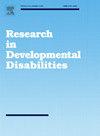Relationship between anxiety and executive functioning among youth with Down syndrome
IF 2.9
2区 医学
Q1 EDUCATION, SPECIAL
引用次数: 0
Abstract
Down syndrome (DS) is commonly associated with various cognitive and behavioral challenges including difficulty with executive functioning (EF) and elevated levels of anxiety symptoms. In the general population, high levels of anxiety are associated with difficulties with EF tasks like initiation and cognitive shifting, with some bidirectional findings between these two constructs. Given the high overlapping behavioral presentation of symptoms of anxiety and challenges in EF, the present study examined the relationship between anxiety symptoms and EF in a sample of 139 individuals with DS ages 6–17 years to better understand their interrelationship and directionality in this population. Participants were rated by parents at two different time points, one year apart. For the entire sample, at baseline, concurrent associations were observed between several measures of EF and measures of anxiety and internalizing symptoms. Among the sample, some participants had co-occurring anxiety diagnoses prior to testing. Our results suggest that those with co-occurring anxiety exhibited more pronounced co-occurring difficulties in several areas of EF than those without co-occurring anxiety. Longitudinally, EF-shifting and EF-working memory at baseline predicted anxiety symptoms a year later while baseline anxiety predicted subsequent challenges with EF-shifting and EF-initiation a year later. Our findings suggest that while there are concurrent relationships between several measures of EF and anxiety, the longitudinal relationship is more nuanced. Our findings highlight the need for targeted mental health interventions in those with DS, as well as awareness of the overlap of anxiety with EF.
唐氏综合症青少年焦虑与执行功能的关系
唐氏综合症(DS)通常与各种认知和行为挑战有关,包括执行功能困难(EF)和焦虑症状水平升高。在一般人群中,高水平的焦虑与启动和认知转移等EF任务的困难有关,这两种结构之间存在一些双向发现。鉴于焦虑症状和EF挑战的行为表现高度重叠,本研究以139名6-17岁的DS患者为样本,研究了焦虑症状和EF之间的关系,以更好地了解它们在该人群中的相互关系和方向性。父母在两个不同的时间点给参与者打分,间隔一年。对于整个样本,在基线时,观察到几个EF测量值与焦虑和内化症状测量值之间的并发关联。在样本中,一些参与者在测试前同时患有焦虑诊断。我们的研究结果表明,与那些没有共同焦虑的人相比,那些有共同焦虑的人在EF的几个方面表现出更明显的共同困难。纵向上,基线时的ef转移和ef工作记忆预测了一年后的焦虑症状,而基线焦虑预测了一年后ef转移和ef启动的后续挑战。我们的研究结果表明,虽然EF和焦虑的几种测量方法之间存在并行关系,但纵向关系更为微妙。我们的研究结果强调了对退行性痴呆患者进行有针对性的心理健康干预的必要性,以及对焦虑与EF重叠的认识。
本文章由计算机程序翻译,如有差异,请以英文原文为准。
求助全文
约1分钟内获得全文
求助全文
来源期刊

Research in Developmental Disabilities
Multiple-
CiteScore
5.50
自引率
6.50%
发文量
178
期刊介绍:
Research In Developmental Disabilities is aimed at publishing original research of an interdisciplinary nature that has a direct bearing on the remediation of problems associated with developmental disabilities. Manuscripts will be solicited throughout the world. Articles will be primarily empirical studies, although an occasional position paper or review will be accepted. The aim of the journal will be to publish articles on all aspects of research with the developmentally disabled, with any methodologically sound approach being acceptable.
 求助内容:
求助内容: 应助结果提醒方式:
应助结果提醒方式:


